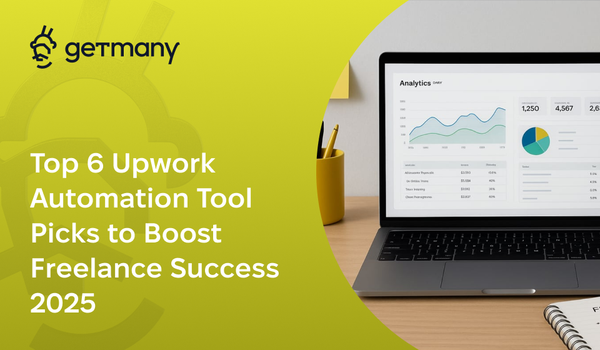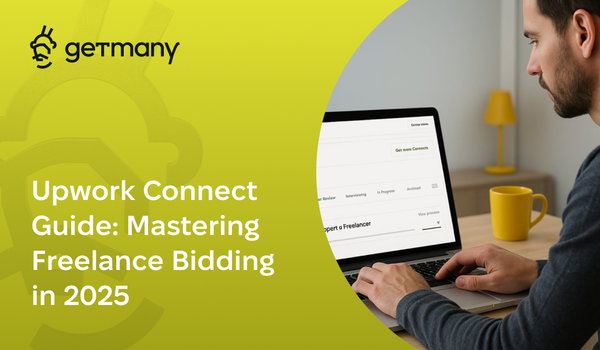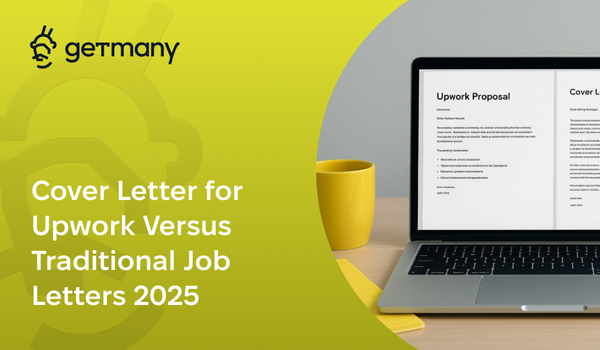Growing from $5k to $50k/Month: A Roadmap for Upwork Agency Owners
The proven framework that took our agency from $5k to $50k monthly revenue. Real numbers, specific strategies, and actionable steps for each growth stage.

The journey from $5k to $50k monthly revenue isn't just about scaling—it's about fundamental transformation. Most agency owners hit plateaus at $8k, $15k, and $25k because they try to scale their freelancer mindset instead of building true business systems.
After studying 500+ agency growth trajectories and personally coaching agencies through this transition, I've identified the exact inflection points, strategies, and systems that separate the agencies that plateau from those that break through to sustainable six-figure monthly revenue.
This isn't theory—it's the battle-tested roadmap that successful agencies use to achieve predictable, scalable growth on Upwork.
The Growth Stages: Understanding Your Journey
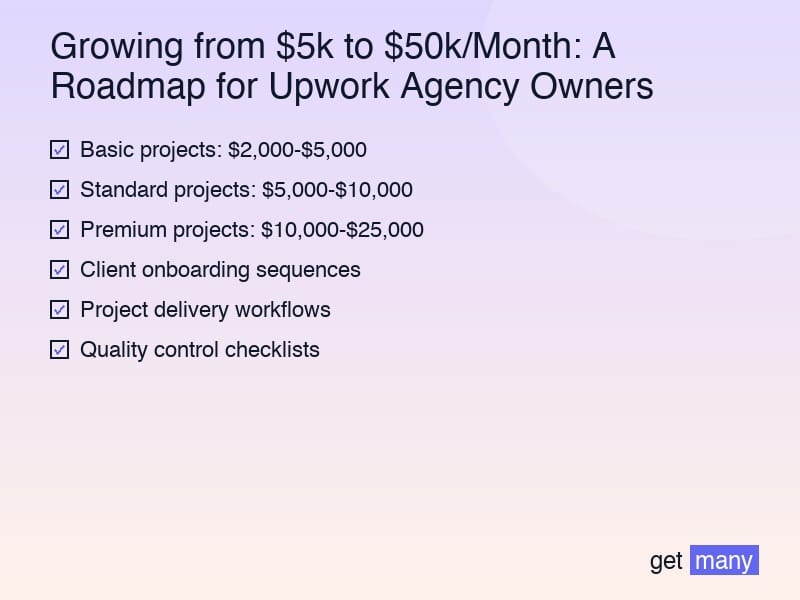
Revenue growth follows predictable patterns. Each stage requires different strategies, mindsets, and systems:
Stage 1: $5k-$8k/Month (The Hustle Stage)
Primary challenge: Inconsistent revenue Key metrics: Win rate, proposal volume, client retention Critical success factors: Personal productivity, proposal quality, client satisfaction
Stage 2: $8k-$15k/Month (The Capacity Crunch)
Primary challenge: Personal bandwidth limitations Key metrics: Utilization rate, average project value, team efficiency Critical success factors: Delegation, process systematization, quality control
Stage 3: $15k-$25k/Month (The Systems Stage)
Primary challenge: Operational complexity Key metrics: Team productivity, client lifetime value, operational efficiency Critical success factors: Team leadership, advanced systems, strategic positioning
Stage 4: $25k-$50k/Month (The Leadership Stage)
Primary challenge: Market positioning and premium pricing Key metrics: Market share, brand recognition, profit margins Critical success factors: Thought leadership, strategic partnerships, premium positioning
Stage 1: From $5k to $8k/Month - Building the Foundation

The Fundamental Shift
At this stage, you're transitioning from "taking what you can get" to "choosing what you pursue." This requires a complete overhaul of your client acquisition approach.
Revenue Optimization Strategy
Target: 20% increase in average project value Method: Strategic positioning and pricing
Pricing framework:
- Basic projects: $2,000-$5,000
- Standard projects: $5,000-$10,000
- Premium projects: $10,000-$25,000
Key tactics:
- Niche specialization: Focus on 2-3 specific industries
- Value-based pricing: Price based on outcomes, not hours
- Proposal optimization: Increase win rate from 15% to 25%
- Client qualification: Reject low-value projects aggressively
System Implementation
Process documentation: Create standard operating procedures for:
- Client onboarding sequences
- Project delivery workflows
- Quality control checklists
- Communication protocols
Technology stack:
- Project management: Asana or Monday.com
- Client communication: Slack or Microsoft Teams
- File sharing: Google Drive or Dropbox
- Proposal generation: Getmany for automation
Metrics to Track
- Monthly recurring revenue (MRR): Target 60% of total revenue
- Client acquisition cost (CAC): Should be <20% of client lifetime value
- Win rate: Target 25% proposal acceptance rate
- Client retention: 80% of clients should provide repeat business
Stage 2: From $8k to $15k/Month - Breaking the Capacity Ceiling
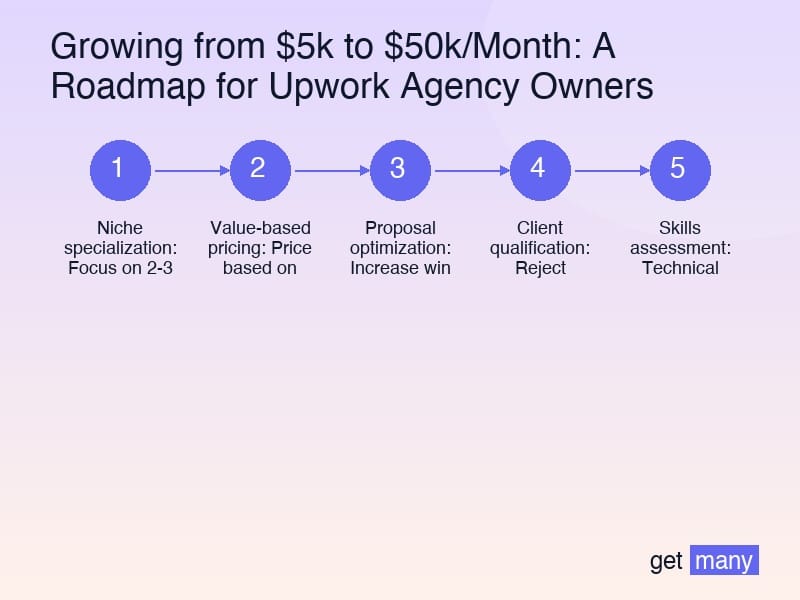
The Multiplication Challenge
You can't personally handle more than $8k-$10k monthly revenue sustainably. Growth requires building systems that work without your constant involvement.
Team Building Strategy
First hire priority: A project manager or virtual assistant Second hire priority: A junior specialist in your core service area Third hire priority: A senior specialist who can handle complex projects
Hiring framework:
- Skills assessment: Technical competence in required areas
- Cultural fit: Alignment with your working style and values
- Growth potential: Ability to take on increasing responsibility
- Communication skills: Clear, proactive communication style
Revenue Diversification
Service expansion: Add complementary services that leverage your existing expertise Retainer development: Convert 40% of clients to monthly retainer agreements Upselling systems: Create natural progression paths for client growth
Example service progression:
- Entry level: Website design ($3,000)
- Mid-level: Brand identity package ($8,000)
- Premium level: Complete digital transformation ($25,000)
Operations Systematization
Standard operating procedures for:
- Client onboarding and expectation setting
- Project scoping and pricing
- Quality control and review processes
- Team coordination and communication
Automation opportunities:
- Proposal generation using Getmany
- Client communication sequences
- Project status updates
- Invoice generation and follow-up
Financial Management
Cash flow optimization:
- 50% upfront payment for new projects
- Net 15 payment terms (maximum)
- Monthly retainer billing
- Separate emergency fund for growth investments
Stage 3: From $15k to $25k/Month - Systems and Leadership
The Leadership Transition
You're no longer a freelancer with helpers—you're a business owner leading a team. This requires new skills and mindsets.
Advanced Team Structure
Core team roles:
- Operations manager: Handles day-to-day coordination
- Senior specialists: Lead complex projects independently
- Junior specialists: Handle routine tasks and support
- Business development: Focused on growth and client acquisition
Team performance metrics:
- Individual productivity rates
- Quality scores and client satisfaction
- Professional development progress
- Team collaboration effectiveness
Strategic Positioning
Market differentiation: Develop unique value propositions that justify premium pricing Thought leadership: Regular content creation and industry participation Case study development: Document and promote your success stories Partnership building: Strategic alliances with complementary service providers
Advanced Systems Implementation
Customer relationship management:
- Sophisticated CRM system for lead tracking
- Client lifetime value optimization
- Referral program development
- Customer success metrics
Financial management:
- Monthly financial reporting and analysis
- Profit margin optimization by service line
- Investment in growth initiatives
- Tax optimization strategies
Quality Assurance
Multi-layered quality control:
- Peer review processes
- Client feedback integration
- Continuous improvement systems
- Industry standard compliance
Stage 4: From $25k to $50k/Month - Market Leadership
The Strategic Shift
Growth beyond $25k requires strategic thinking, not just operational excellence. You're competing for enterprise clients and premium positioning.
Premium Market Positioning
Target client profile:
- Enterprise-level organizations
- Annual budgets exceeding $100k
- Complex, strategic projects
- Long-term partnership potential
Positioning strategy:
- Expertise-based pricing: Charge for knowledge, not time
- Outcome guarantees: Confidence in delivering results
- Thought leadership: Regular speaking and writing opportunities
- Strategic partnerships: Collaboration with industry leaders
Enterprise Sales Process
Multi-touch sales funnel:
- Initial qualification: Comprehensive needs assessment
- Strategy consultation: Free strategic planning session
- Proposal presentation: Formal presentation with stakeholders
- Negotiation and closing: Contract terms and project scoping
- Onboarding: Executive-level relationship building
Advanced Financial Management
Revenue optimization:
- Retainer growth: 70% of revenue from recurring clients
- Upselling systems: Average client value increase of 150%
- Profit margin focus: Target 40%+ profit margins
- Investment allocation: 20% of revenue reinvested in growth
Technology and Systems
Enterprise-grade systems:
- Advanced CRM: Salesforce or HubSpot
- Project management: Enterprise-level tools with client access
- Financial systems: QuickBooks Enterprise or NetSuite
- Communication: Professional video conferencing and collaboration tools
The Critical Success Factors at Each Stage
Stage 1 Success Factors ($5k-$8k)
- Personal productivity optimization
- High-quality proposal writing
- Consistent client delivery
- Basic systems and processes
- Financial discipline
Stage 2 Success Factors ($8k-$15k)
- Effective delegation
- Team building and management
- Process systematization
- Quality control systems
- Cash flow management
Stage 3 Success Factors ($15k-$25k)
- Leadership development
- Strategic positioning
- Advanced systems implementation
- Team performance optimization
- Market differentiation
Stage 4 Success Factors ($25k-$50k)
- Enterprise sales capabilities
- Premium market positioning
- Strategic partnerships
- Thought leadership
- Advanced financial management
Common Pitfalls and How to Avoid Them
The Pricing Trap
Problem: Competing on price instead of value Solution: Focus on outcomes and ROI for clients
The Hiring Mistake
Problem: Hiring too late or too early Solution: Hire when you're at 80% capacity for three consecutive months
The Systems Neglect
Problem: Avoiding process documentation Solution: Document everything before you need it
The Quality Compromise
Problem: Sacrificing quality for speed Solution: Build quality control into every process
The Cash Flow Crisis
Problem: Not managing cash flow during growth Solution: Maintain 3-6 months of operating expenses in reserve
The Technology Stack for Each Stage
Stage 1 Tools ($5k-$8k)
- Proposal generation: Getmany
- Project management: Trello or Asana Basic
- Communication: Slack Free
- File sharing: Google Drive
- Accounting: QuickBooks Simple Start
Stage 2 Tools ($8k-$15k)
- Project management: Asana Premium or Monday.com
- CRM: HubSpot Free or Pipedrive
- Communication: Slack Standard
- Time tracking: Toggl or RescueTime
- Accounting: QuickBooks Essentials
Stage 3 Tools ($15k-$25k)
- Project management: Monday.com Pro or Asana Business
- CRM: HubSpot Professional or Salesforce Essentials
- Communication: Slack Plus or Microsoft Teams
- Analytics: Google Analytics and custom dashboards
- Accounting: QuickBooks Plus with advanced features
Stage 4 Tools ($25k-$50k)
- Project management: Enterprise-level solutions
- CRM: Salesforce Professional or HubSpot Enterprise
- Communication: Enterprise communication suites
- Analytics: Advanced business intelligence tools
- Accounting: QuickBooks Enterprise or NetSuite
The Financial Modeling Framework
Revenue Projection Model
Monthly revenue target: $R Average project value: $APV Win rate: W% Projects needed: R / APV Proposals needed: (R / APV) / W%
Example: $30k Monthly Target
- Average project value: $5,000
- Win rate: 25%
- Projects needed: 6 per month
- Proposals needed: 24 per month
Cost Structure Optimization
Target cost allocation:
- Team costs: 40-50% of revenue
- Operations: 15-20% of revenue
- Marketing: 10-15% of revenue
- Owner compensation: 25-30% of revenue
The Getmany Advantage in Growth
As your agency grows, proposal writing becomes a significant bottleneck. The math is clear:
Stage 1: 20 proposals/month × 45 minutes = 15 hours Stage 2: 35 proposals/month × 45 minutes = 26 hours Stage 3: 50 proposals/month × 45 minutes = 37 hours Stage 4: 75 proposals/month × 45 minutes = 56 hours
Getmany transforms this equation by:
- Automating proposal generation: Reduce time per proposal from 45 minutes to 5 minutes
- Improving win rates: Learn from successful proposals to increase acceptance rates
- Enabling scale: Handle proposal volume that would be impossible manually
- Maintaining quality: Consistent, professional proposals at scale
This automation frees up 40+ hours per month that can be invested in strategic activities, team building, and client relationship development.
Your Growth Action Plan
Month 1: Foundation Assessment
- Analyze current revenue streams and profitability
- Document existing processes and systems
- Identify bottlenecks and growth constraints
- Set up tracking and measurement systems
Month 2-3: Strategic Implementation
- Implement systems appropriate for your current stage
- Begin team building process if needed
- Optimize pricing and positioning
- Establish quality control processes
Month 4-6: System Optimization
- Refine processes based on results
- Expand team capabilities
- Develop strategic partnerships
- Build thought leadership presence
Month 7-12: Scale and Measure
- Execute growth strategies consistently
- Monitor and adjust based on metrics
- Prepare for next growth stage
- Build sustainable competitive advantages
Key Performance Indicators by Stage
Stage 1 KPIs
- Monthly recurring revenue growth
- Proposal win rate
- Client satisfaction scores
- Personal productivity metrics
Stage 2 KPIs
- Team productivity rates
- Client lifetime value
- Operational efficiency ratios
- Cash flow stability
Stage 3 KPIs
- Market share in target niches
- Team performance metrics
- Brand recognition indicators
- Profit margin optimization
Stage 4 KPIs
- Enterprise client acquisition
- Thought leadership metrics
- Strategic partnership value
- Premium pricing acceptance
The Bottom Line
Growing from $5k to $50k monthly revenue requires more than just doing more of the same. It demands strategic thinking, systematic implementation, and the courage to evolve your business model at each stage.
The agencies that successfully make this transition understand that each growth stage requires different skills, systems, and strategies. They invest in building the foundation for the next stage before they reach their current capacity limits.
The roadmap is clear, but execution requires discipline, patience, and the right tools. Success isn't guaranteed, but with the right approach, it's predictable.
Remember: Revenue growth is a byproduct of value creation. Focus on consistently delivering exceptional value to your clients, and the revenue will follow.
Ready to accelerate your agency's growth? Getmany can automate your proposal process, freeing up 40+ hours per month to focus on strategic activities that drive revenue growth. Start your transformation today and build the agency you've always envisioned.



